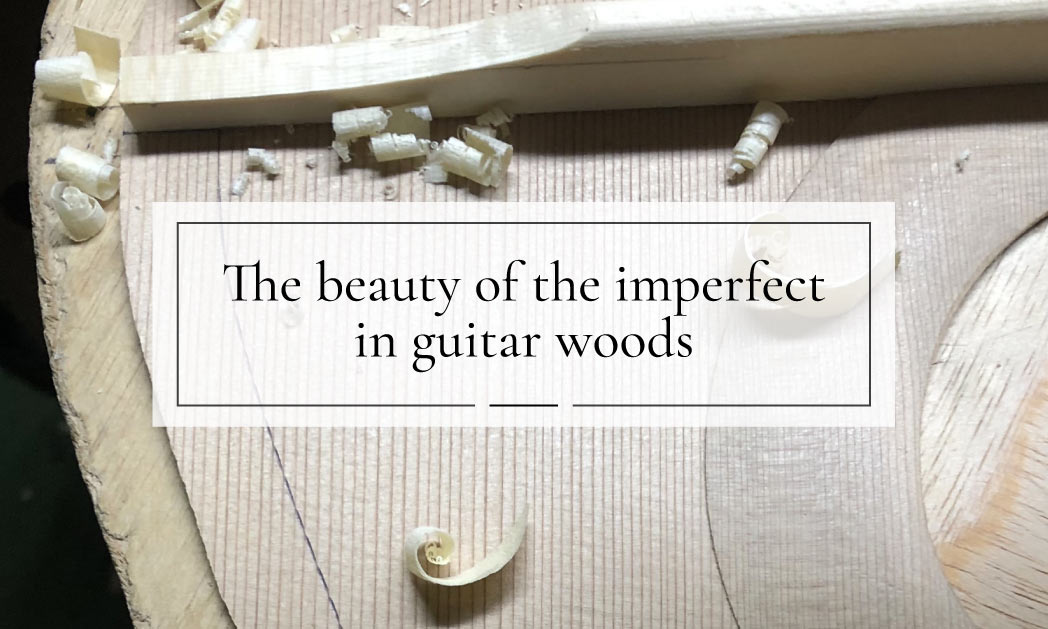I grew up hearing about the defects in the woods used in guitars, the knots, the cocas, the veins of irregular tones… and for me it became something quite normal until I began to see that woods whose appearance was not adequate were discarded in the search for an absurd, misunderstood perfection, woods that were beautiful with their spots and irregularities, woods that once put in a guitar sounded good, as good and sometimes even better than others whose appearance was homogeneous and, if I dare say, even boring.
My father started to use those woods for guitars that he called second class guitars (2nd class on the label), although the construction quality was the same as the first class ones, but he knew that he was going to be criticized because of the appearance of the woods. And later we have done the same thing again because a supposed aesthetic defect cannot be above the quality of the sound.
In the search for the pristine and, at the same time, for the imperishable, the immortal… all so alien to nature, we have been destroying our world, cutting down trees indiscriminately and using a small part of them, considering the rest as waste material. Something similar to the manufacture of plastics, perfect, indestructible… For me these are processes that go hand in hand in a denial of the natural, like so many others.
So-called defects of guitar woods
Of course, we are not going to accept woods with cracks or with knots that can turn into holes, all unacceptable for building a guitar, it is obvious. But the so-called defects of wood are actually peculiarities produced by nature, the capricious nature that loves unique, unrepeatable, singular forms. Just as no two fingerprints are alike, no two trees are alike.
Even the wood of the same tree takes on different shapes in each piece, because it is life passing through its veins and rings, and because one moment is never the same as the next, and that is engraved in the tree’s experience.
I don’t like having to use wood to build our guitars, and I only take comfort in knowing that their life will continue as music in instruments as different from each other as their wood, because even though the construction of a guitar is identical to that of its sister guitar (we usually make them, traditionally, four by four), each one will have a different sound, even though the soul is the same.
Yes, the soul, the soul of the trees that participate in their elaboration together with the soul that we put in them during their construction, but then the soul with which the guitarist impregnates their veins.
The care with which wood is treated
My father (JR III) used to lament the mistreatment to which the Brazilian rosewood was systematically subjected, the abuse of its uncontrolled felling and its absolute lack of protection.
In his book “En torno a la Guitarra” he says:
“Talking one day with a Brazilian lumber dealer, I found out that there were many loggers who, not bothering to use a saw or an axe to cut down a rosewood, followed the simple procedure of making a hole at the base of the trunk, put an explosive charge and the thing was solved with the greatest comfort. Naturally, the explosion produced unnecessary cracks along the whole length of the trunk, which reduced considerably its use, but this did not matter, there were many trees”.
And another anecdote that he often told us recalling his father José Ramirez II, and that he also tells in his book, could not be more descriptive about the contempt with which the woods, our forests, our trees, are treated:
“My father told me that, on one of his trips, he was in Rio de Janeiro for several days in 1925 and that, walking through the city and contemplating how they were asphalting a street, he saw something that in his first sensation he considered to be a false impression of the senses, but no, it was an incredible reality: the fire of the boilers to melt the material, was fueled by pieces of the most splendid dalbergia nigra cut from mind-boggling planks. He immediately got in touch with the building contractor with whom he soon became friendly with the help of a few drinks and proposed the purchase of those wonderful planks. The contractor, who must already be in the ineffable stage of friendly protests, promised him that he would send him to Spain not only those planks that were worth nothing to him, but some more and for free. My father insisted on paying him to seriously compromise what he saw as doubtful. The contractor was even offended to be doubted by his <<sincere>> friendly offer. My father, may he be glorified, is still waiting for the planks”.
Fortunately now there are lumber companies that take care of the environment, that work responsibly, that replant and ensure the continuity of the species, and that is a blessing that has fallen upon us guitar makers. And it would be good for us to learn to consciously thank the trees, the precious trees, that we can use their precious woods, with their unique peculiarities, to be able to do our work.
And in this context one could ask oneself if the loved one is less beautiful for having a mole, a spot, a scar…
The beauty of the imperfect in guitar woods
We have long since learned to appreciate the beauty of the imperfect, that’s why, without going any further, we like ebony with lighter veins or with color changes, because those irregularities are part of its nature, they do not harm neither the aesthetics nor the sound or the quality of the wood, and it does not have to be totally black to be valuable and worthy of the best guitar.
Many builders of acoustic guitars, as well as electric guitars, for example, use the peculiarities of the woods as part of the design, such as knots and claws, the latter being favourable for the sound.
Some people don’t like the mirroring on the tops, when this occurs when a log is opened up against the grain and not across it when sawing. And the mirror adds a special consistency to the caps, and also benefits the sound. For this reason, it is more advisable to use wood that has been extracted from logs that have been opened with a wedge, following the direction of the grain.
The importance of seasoning guitar woods
And yes, whatever the aesthetics of the wood, what is essential is that they are well cured by the passage of time, which not only affects the sound quality, but in the stability of the instrument avoiding movements that can produce cracks and discoloration, shrinkage and expansion.
And of course, natural ageing is always preferable, although artificially accelerated ageing in drying sheds is also acceptable, but it is preferable to leave the drying process to the passage of time in a suitable environment.
Thus, my father bought an important quantity of wood between the 50’s and 70’s that we have kept in our warehouse in suitable conditions for its natural drying. Even today we continue to use those woods as we buy others to undergo the same aging process so that we can use them in future guitars.
Those 2nd class guitars that my father made in his day to use the woods that rebelled showing the beauty of their imperfections, it turns out that a clever dealer, whose name is not worth mentioning, has been selling them as if they were better than the 1st class ones and therefore with an overprice, when he bought them with a discount because they were 2nd class. This should help us to understand the meaninglessness of the canons of beauty by which we are so often and so absurdly guided.
Now that we are beginning to become aware of the damage that, with so much perseverance, we have been causing to nature, the concept of the imperfect is also changing, fortunately for all of us. Understanding that there are no imperfect woods is a fundamental step in this process.
We are well on our way to developing a line of guitars with “quirky” woods that we refuse to discard, and we are sure that many will be proud to have one of these guitars as their everyday musical companion. Are you up for the challenge?
Madrid 21 October 2020
Written by Amalia Ramírez.


